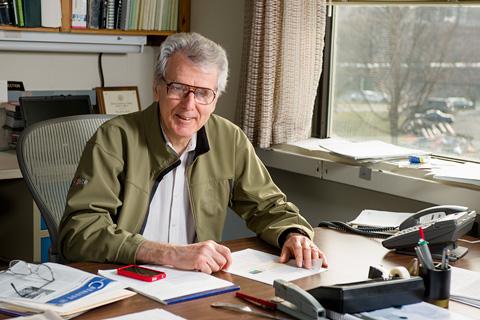By Carolynne Keenan, Contributing Writer
When Larry Keefer, Ph.D., first arrived at the National Cancer Institute (NCI) more than 40 years ago, he didn’t have a physical lab to call his own. Not immediately, anyway, due to a glitch in the construction schedule, he explained.
So he spent his first few years in Bethesda doing administrative work, like reviewing proposals and serving as a project officer on contracts.
“When my lab was finished, things really took off,” Keefer said. Research publications began to flow, mostly focused on the chemistry of carcinogenic nitrosamines—chemical compounds that exist in many manufactured, consumable products, including food.
During his first 20 years at NCI, Keefer’s group researched ways to reduce human exposure to carcinogenic nitrosamines, including finding ways to block their formation in the environment. His group’s aim has always been to use “knowledge gained from our basic chemistry research effort to design new cancer prevention strategies, as well as novel drug candidates and procedures that might improve clinical medicine,” Keefer explained.
Following his 1983 transfer to NCI at Frederick, the Keefer group shifted its emphasis from nitrosamine chemistry to the newly discovered biological roles of nitric oxide (NO), and “how we could influence the body’s NO levels for possible therapeutic effect,” Keefer said.
His lab is now located in the Chemical Biology Laboratory (CBL), in the Center for Cancer Research (CCR), NCI. The CBL combines the fields of chemistry, biology, and material sciences, and conducts basic research in cancer and AIDS diagnoses and treatments. Keefer now serves as the head of CBL’s Drug Design Section.
The CBL evolved from the Laboratory of Medicinal Chemistry, which was historically the focal point for chemical research at NCI, according to the CBL website.
Finding Chemistry’s Place
A scientist who has been at NCI for more than four decades would have seen many changes over the years, and Keefer is no exception. NCI’s mission of conducting research into the cause, diagnosis, prevention, and treatment of cancer may not have changed over the years, but the scope of its research has.
When Keefer first arrived at NCI, chemistry as a discipline was not held in high regard, he explained. “For many years, I sought to demonstrate in my work that chemistry can make an essential contribution to the fundamental mission of the NCI,” he said.
Keefer said his lab worked to prove chemistry’s value in scientific research. “Many problems in biomedical research are best tackled using the concepts and techniques of chemistry,” Keefer said.
Now chemistry is a major component of NCI’s mission—thanks in part to CBL’s research. “The most exciting change I’ve seen in my 40-plus years here is the investment our current leadership has made these past few years in establishing a world-class Chemical Biology Laboratory with a great lab chief and outstanding PIs [principal investigators], including gifted new tenure trackers,” Keefer said.
Building a “Superb” Team
There may be many reasons Keefer has built his career at NCI at Frederick, but for him, a top reason is NCI’s staff. He called the CBL scientists and staff “superb” and ranked the opportunity to interact with them as one of the best parts of his job.
He said he enjoys the freedom to determine the direction of his section’s research program, and he works hard to prove that his team’s projects are worthy of continued funding.


